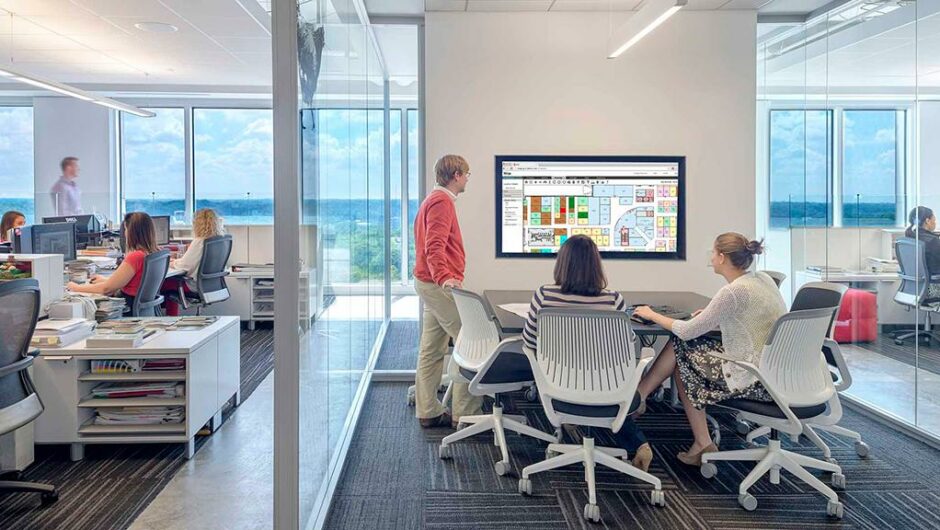Return-to-office planning is ramping up and as many companies have experienced tremendous change in headcount over the past two years, the transition back to the office introduces the challenge of welcoming new team members and reorienting existing employees. While this is a positive sign for businesses, we know that it’s a heavy lift to coordinate space, desks, and resources for new and returning workers.
Since there is no one-size-fits-all approach, we’ve outlined 10 considerations, tools, and methodologies that can help guide organizations that are facing the same unprecedented challenges — and opportunities — to create a better workplace experience in the post-pandemic era.
1. Understand a variety of workplace models.
As companies rethink their square footage needs, they are faced with a new challenge of finding a balance between potentially relinquishing their physical space and leaning more on remote working and relying on the office to create shared human experiences and collaboration. While some companies are returning to their previous workplace strategy of assigned seating, many are evaluating the changing needs of workers and trying new workplace planning strategies to optimize productivity and satisfaction.
The hybrid workplace approach is a leading model at this time — our research shows that over half of workers would prefer a hybrid model, or a mix of working from the office and working from home during the typical workweek. Leveraging lessons learned during the pandemic, companies are implementing elements of in-person and remote work that best support their unique goals and foster stronger employee engagement and productivity.
Some of our clients are focused on a choice-based model, which empowers employees to determine when and where they are most productive to complete their work. In this model, employees might need to return to the office two or three days per week or they have ‘full choice’ in choosing when, why, and where they work in the office, based on minimal policy control.
A schedule-based hybrid work model features choreographed days of the week, or even on a monthly or quarterly basis, where leadership and employees are scheduled to intentionally overlap to coordinate meaningful time together. This allows teams to foster connections with new members and to build and rebuild social networks and capital with one another as well as work-related purposes.
In a purpose-based model, organizations look deeply into job function, role, and work-based processes and activities to prioritize those personas best suited to work fully or mostly remote, two to three days in the office, or most days in the office. This involves rethinking workspace planning solutions to focus on creating synergy with simultaneous different personas and purposes.
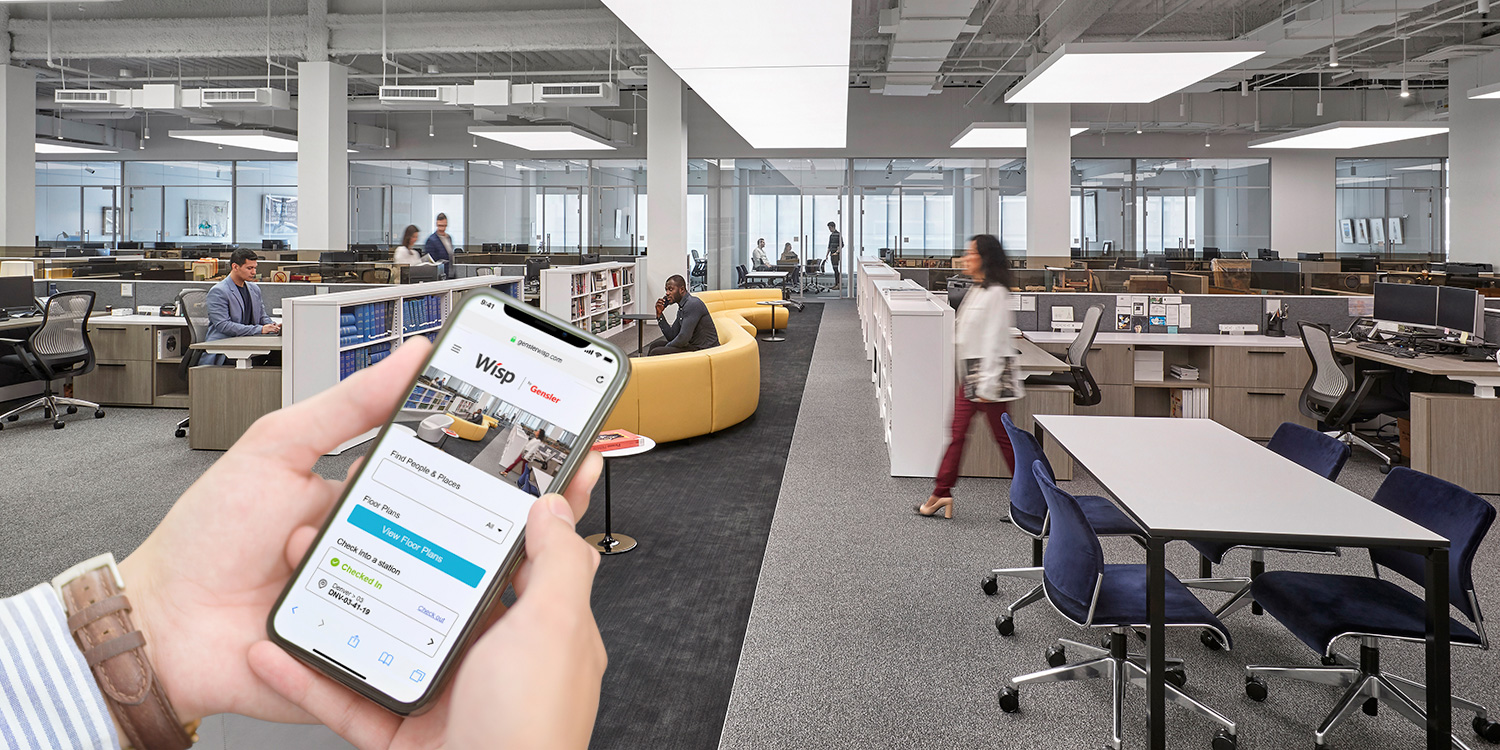
A hybrid workplace enables with the right tools and technology. Our space management software, Wisp, supports flexibility in the workplace by supporting desk reservations, neighborhoods, wayfinding, and the features needed for an evolving workplace strategy.
2. Rethink the new role of the workplace — not just the workplace itself.
During this time of transformation, we are partnering with clients to rethink where work takes place — and redefine what the workplace is altogether. In urban environments, we are looking at the whole city as the workplace, with the potential to work anywhere between home and third spaces. We can adapt to new ways of working by incorporating flex spaces into our workplace models. Within the office, our designers and strategists are identifying space typologies to support unique needs like activity-based working, R&D spaces, and collaboration hubs.
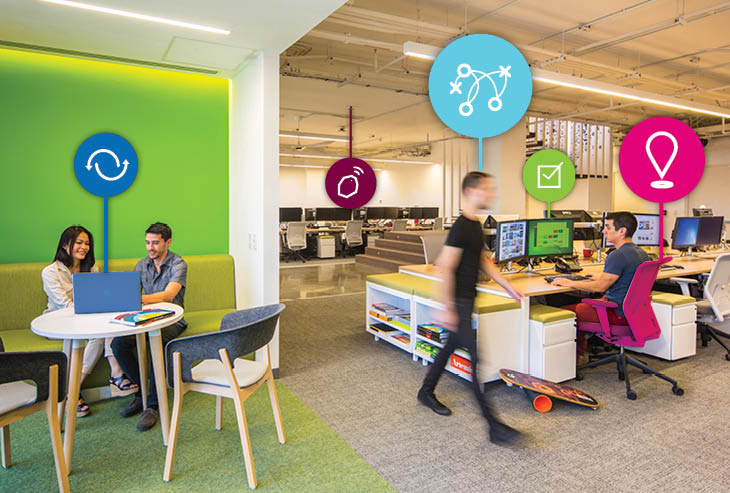
Providing choice and flexibility in the workplace allows workers to determine when and where they are most productive in the office.
3. Take stock of your space metrics.
Over the past two years, company headcounts have fluctuated greatly. While some companies reduced headcount, many grew — with some adding hundreds to thousands of new workers. Many of these new hires have not yet set foot in the company office. Assessing key metrics like headcount, seat count, and ratios is the basis for informing the type of workplace strategy to implement — ideally one that will accommodate the space needs of workers.

Space and occupancy datasets continue to be foundational for understanding inventory and measuring demand on space. Measuring multiple dimensions of your workspace — vacancy, occupancy ratios, space efficiency, and more. — is the best way to activate one of your greatest assets that may be hiding in plain sight.
4. Optimize your collaboration spaces — or consider taking on more space.
The journey back to the workplace will require companies to strategically rethink how the office can accommodate new employee expectations and ways of working.
There are many fresh opportunities to leverage the physical workspace to emphasize and serve many more purposes than it offered pre-pandemic. The need to support more social networking, more training, learning and mentoring, new recruit immersion and customer engagement experiences, and more team collaboration, are all redefining workplace occupancy, purpose, and how much space companies need as they return to the reimagined office.
As the physical-digital hybrid places have created a greater need for both dedicated purpose and flexible multi-purpose types of spaces, the 2019 norms of 1:1 workstation-to-collaborative seats is shifting to the 1:4 to 1:5 range, and this is driving new purpose-driven experiences and informing the amount of space for the workplace.
Our research data shows that people at top-performing companies value the physical workplace and look forward to resuming in-person work. Top-performing companies are three times more likely to increase their real estate footprint in the future because of the need to accommodate more people and more kinds of spaces for a range of work activities.
It’s important that companies right-size their supply and demand. Post-pandemic, some of our clients are recognizing the need for more collaboration spaces for workers. With their hybrid employees shifting alternate days to come into the office, these companies are reducing their work seats in favor of increasing collaboration zones to encourage more connection and spur innovation.

Our research data shows that people at the top-performing companies value the physical workplace and look forward to resuming in-person work. Top-performing companies are three times more likely to increase their real estate footprint in the future because of the need to accommodate more people and more kinds of spaces for a range of work activities.
5. Our post-pandemic work and meeting spaces need to work harder for us.
When it comes to hybrid work, it is not enough to only design for the in-office experience. Spaces for scheduled and impromptu meetings that are inclusive for both in-person and remote participants require the strategic placement of furniture, whiteboards, screens, microphones, and cameras. The goal is to create equitable and productive experiences on both sides of the camera.
Gone are the days of large conference rooms with big central tables and small screens positioned at one end of the room. Today’s workspace planning solutions may eliminate the table altogether in favor of a standup meeting in front of a large screen, where proximity to the screen does a better job mirroring a face-to-face conversation. Other solutions include large monitors (and whiteboards) on wheels that support impromptu meetings wherever the team happens to land. Others dock tables directly to the wall to improve in-person and remote proximity. Creating smart meeting protocols is also helpful — lunch meetings, side conversations, and the meeting after the meeting all require new practices to keep the remote team fully included in information sharing, decision-making, and the social side of being part of the team.
6. Choose the right technology to enable a hybrid workplace.
From desk reservations to wayfinding, the right workplace technology is critical for enabling a dynamic workforce. Through our research, we found that “working in person with my team/colleagues” was universally ranked as the #1 reason workers want to be present in the workplace, across all six countries we surveyed. Socializing with colleagues, being part of the community, or impromptu face-to-face connections were also factors ranked highly by employees.
As companies roll out hybrid working and combine mobile, assigned, and hoteling people on the same floor plan, employees must be able to find each other to work together. Wayfinding applications enable employees to easily locate people, spaces, or conference rooms from their device of choice. When it comes to desk reservations, QR codes are a great visual reminder for employees to check into their desks when they arrive at the office.
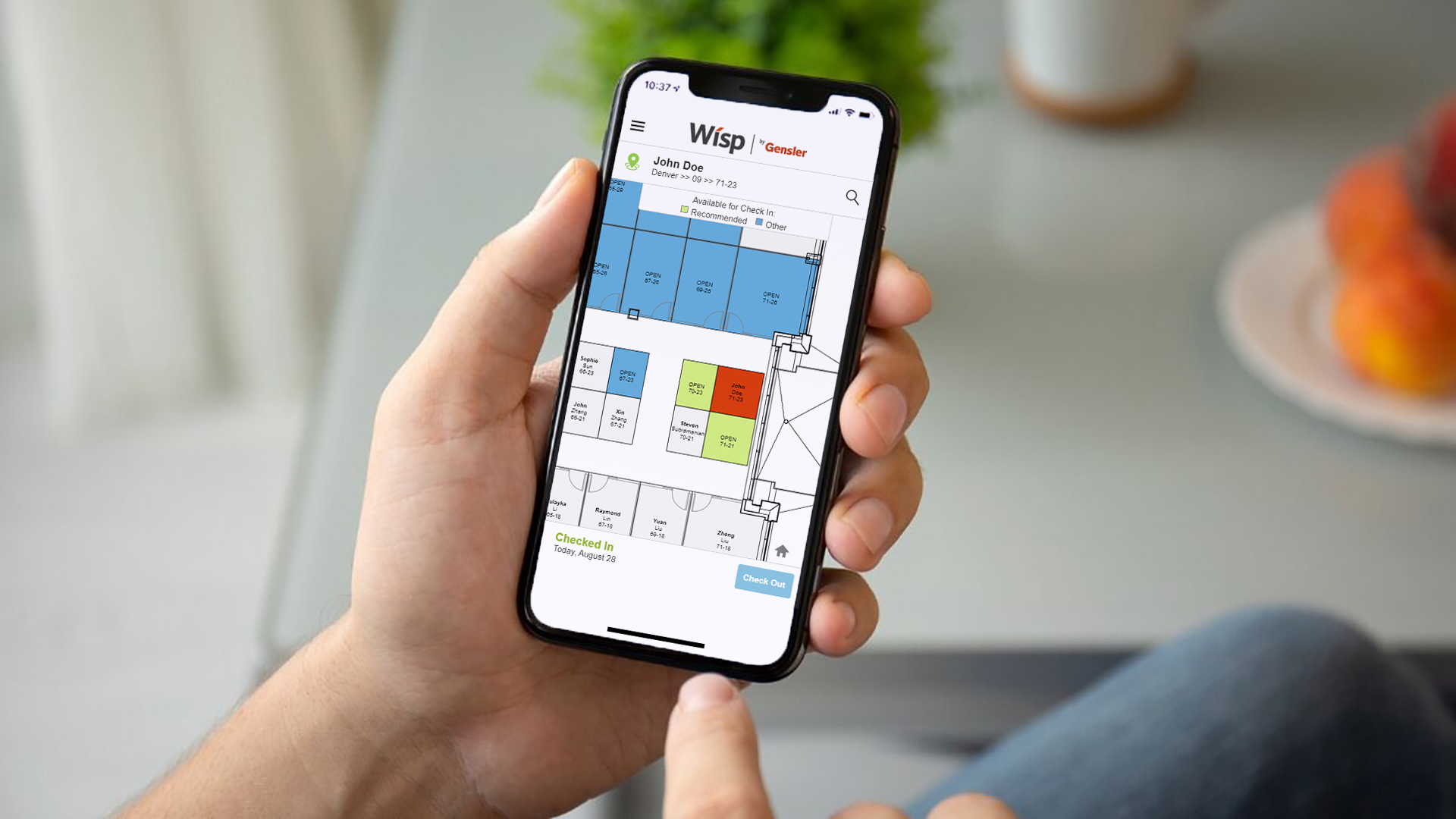
Wayfinding with Wisp makes it easy to locate people and spaces in the workplace through search and visually navigating a floor plan.
7. Amenities take on new meaning post-pandemic.
At home, few of us have the potential to replicate the social connections that meaningful office amenities help foster. Today, the most valuable office amenities play a key role in humanizing the work experience and holistically deliver purpose with a focus on physical, emotional, and spiritual well-being. Places to lounge and decompress support workers in addition to walking paths, exercise spaces, and healthy food. Third spaces like work cafes, libraries, and business lounges offer informal ways for employees to benefit from mentorship, absorb the culture, and build camaraderie and social networks.
8. Plan and communicate cleaning regimens.
Looking to the future, organizations are focused on inclusive wellness programs that blend health, mindfulness, and hygiene principles and policies to support their teams and families. In the office, where multipurpose and shared spaces may be the norm, physical and visible cleaning regimens are the new standard.
As we enter the endemic stages and offices reopen, there are pandemic influences that will stick with us as well as new habits and hygienic expectations. Pandemic influences like air purification, regular cleaning, and disinfecting plans and policies are still in place along with the sanitizing wipes and hand sanitizers. Some users are individually taking care to clean as they go but cleaning services are still paramount to the overall plan. Beyond the current state, as we look to a less intensive workstation environment and more multi-purpose spaces visible evidence of in-room supplies and, in some cases, a ‘mint on the preverbal pillow’ as evidence of a clean room is a good idea to start the day and build confidence with space users.
9. Prioritize change management.
The saying goes: Never put an unchanged person in a changed environment. A workplace change management or communication program can solve for this. As employees return to the office, clear and consistent communications on new protocols, how space is allocated, technology changes, and COVID-related guidelines, will help align office and organization-wide expectations.
Using the return to the office is a wonderful opportunity to design or redesign office protocols and define work behaviors. Many clients are using the transition back to the office to introduce space-sharing strategies, clean desk policies, and more intentional scheduling of social activities to draw larger attendance. Signage and wayfinding graphics can inform and reinforce new protocols and communicate a positive message that welcomes employees back.
10. Continue to test and optimize your workplace strategy.
The work of optimizing and maintaining a workplace strategy is never complete. Whether implementing a hybrid, free address, or dedicated seating model, space and occupancy datasets will continue to be foundational metrics for understanding space inventory and measuring demand on space. Access to current floor plans and occupancy data enables organizations to quickly respond to changing business needs and new ways of working. Tracking key metrics such as density or seat-to-occupant ratio can become the basis for informed real estate and workplace strategy decisions. Maintaining a central repository of up-to-date floor plans provides the opportunity to layer additional qualitative and quantitative datasets that can inform and measure the effectiveness of workplace strategies, such as occupancy sensor data.
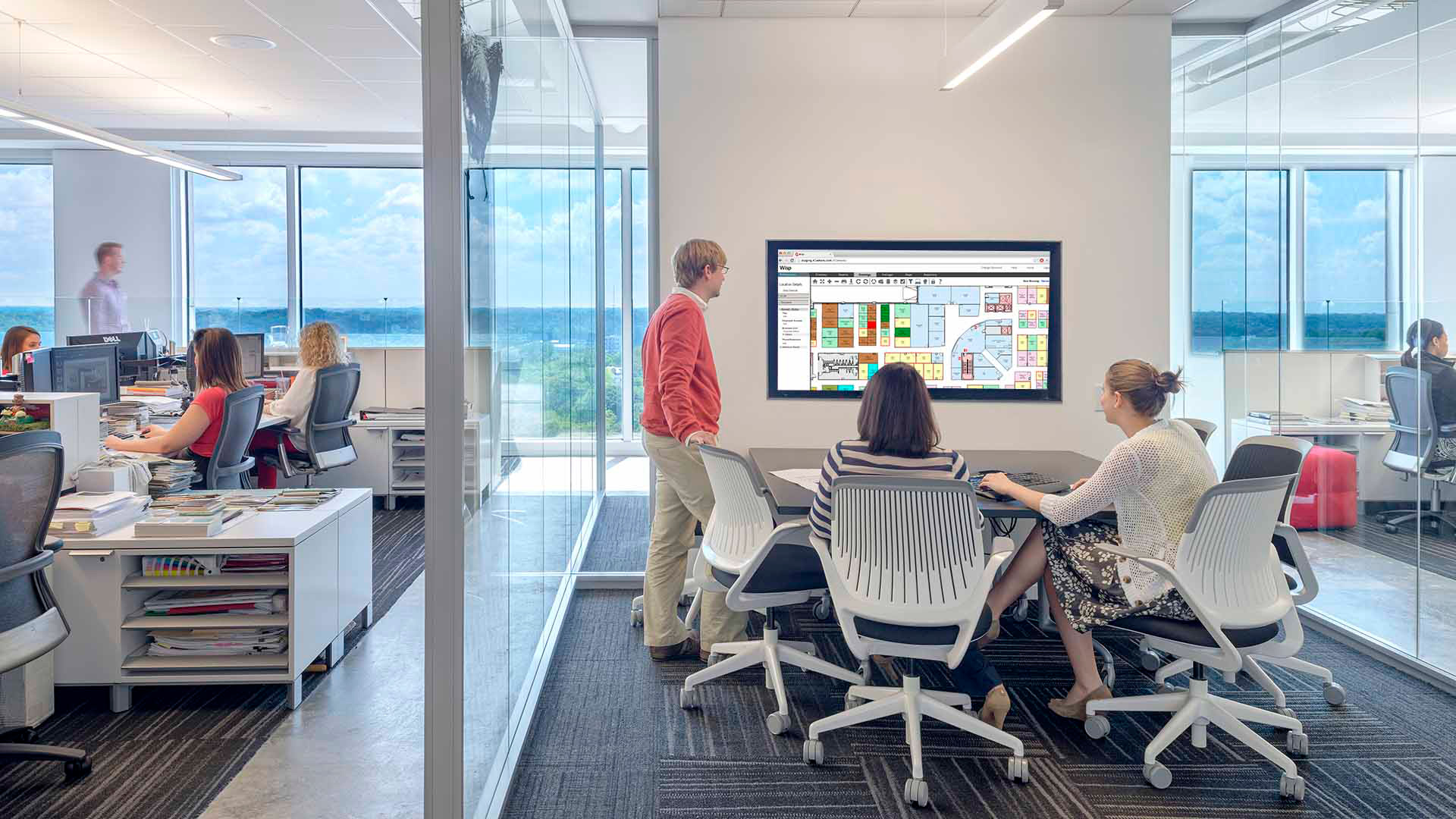
In today’s fast-paced world, immediate access to the right tools and information is critical to running a business swiftly and confidently. Wisp delivers real time reporting with tools and functionality that real estate and facility teams need for strategic planning and daily management.
If your future workplace includes a combination of flexible, hoteling, and/or dedicated seating you need a tool to manage all of it. At Gensler, we are using strategic planning tools like our Wisp space management software, new technology, and data-driven insights to help clients get back to the office and optimize their workspaces for the hybrid era.
Schedule a demo of Wisp or contact our team below.
For media inquiries, email media@gensler.com.


